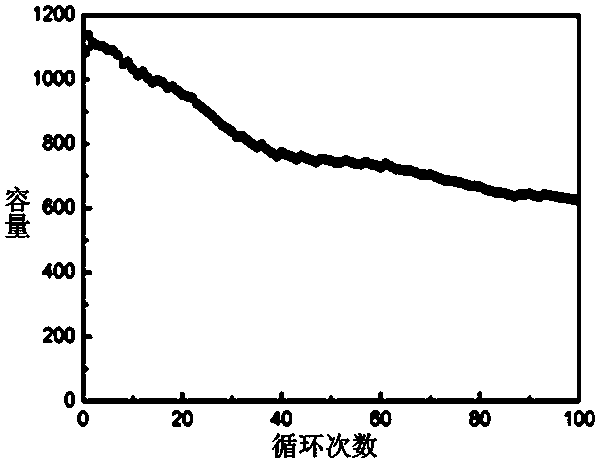A kind of preparation method and application of graphene composite metal boride and sulfur composite nanomaterial
A technology of composite nanomaterials and metal borides, applied in structural parts, electrical components, battery electrodes, etc., can solve problems such as lithium polysulfide shuttle effect, and achieve clean and environmentally friendly preparation process, high commercial value, and catalytic discharge process Effect
- Summary
- Abstract
- Description
- Claims
- Application Information
AI Technical Summary
Problems solved by technology
Method used
Image
Examples
specific Embodiment approach 1
[0023] Specific embodiment 1: This embodiment records a method for preparing graphene composite metal boride and sulfur composite nanomaterials, and the method steps are as follows:
[0024] Step 1: Dissolve sodium borohydride and NaOH in deionized water under inert gas protection to obtain a reducing agent solution, where the concentration of sodium borohydride and NaOH are both 0.5-3M, and dissolve the metal salt in deionized water. Obtain a metal salt aqueous solution with a concentration of 0.5-2M, and place the obtained reducing agent solution and metal salt aqueous solution separately in an ice water bath for 15 minutes;
[0025] Step 2: Under the protection of inert gas, slowly add the metal salt aqueous solution after the ice water bath to an equal volume of the reducing agent solution at a rate of one drop per second, and stir for 30-60 minutes to obtain a dried product, and then place the dried product in Calcined at a temperature of 350-500℃ for 2~10h to obtain metal bor...
specific Embodiment approach 2
[0028] Specific embodiment two: a method for preparing graphene composite metal boride and sulfur composite nanomaterials described in specific embodiment 1, in step 1, the metal salt is iron salt, cobalt salt, nickel salt, and molybdenum salt Kind of.
specific Embodiment approach 3
[0029] Specific embodiment three: a method for preparing graphene composite metal boride and sulfur composite nanomaterials described in specific embodiment 1, in step 2, the morphology of the metal boride is nanowires, nanorods, and nanospheres One of nanosheets, nanoparticles, nanoarrays, nanoflowers, and nanocubes is determined by its experimental temperature, adding speed and concentration; the surface defects of the material can be controlled by the calcination temperature.
PUM
 Login to View More
Login to View More Abstract
Description
Claims
Application Information
 Login to View More
Login to View More - R&D
- Intellectual Property
- Life Sciences
- Materials
- Tech Scout
- Unparalleled Data Quality
- Higher Quality Content
- 60% Fewer Hallucinations
Browse by: Latest US Patents, China's latest patents, Technical Efficacy Thesaurus, Application Domain, Technology Topic, Popular Technical Reports.
© 2025 PatSnap. All rights reserved.Legal|Privacy policy|Modern Slavery Act Transparency Statement|Sitemap|About US| Contact US: help@patsnap.com



